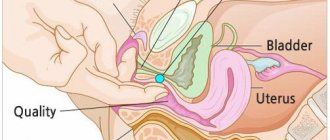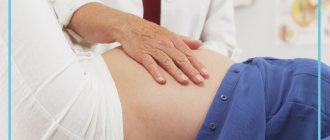Weight gain
The main change that occurs in the appearance of the expectant mother is that she gains weight. Even if in the first months there was toxicosis and the weight fell, then it must begin to grow, as nature intended.
Statistics show that the slimmer a girl was before pregnancy, the more kilograms she usually gains while expecting a child.
Weight gain is a guarantee that everything is fine with the baby. After all, your weight increases because the fetus gains weight, the placenta, amniotic fluid and umbilical cord appear, and blood volume increases. And, of course, adipose tissue appears - this is insurance during breastfeeding.
You can calculate the acceptable weight gain yourself. To do this, you need to know your height and starting weight, which is then converted into a BMI index. Calculate your BMI: BMI = weight/height² (kg/m²).
Results:
- BMI < 19.8 – thin women;
- BMI = 19.8–26.0 - women of average build;
- BMI > 26 – obese women.
| Week of pregnancy | BMI < 19.8 | BMI = 19.8–26.0 | BMI > 26.0 |
| 2 | 0,5 | 0,5 | 0,5 |
| 4 | 0,9 | 0,7 | 0,5 |
| 6 | 1,4 | 1,0 | 0,6 |
| 8 | 1,6 | 1,2 | 0,7 |
| 10 | 1,8 | 1,3 | 0,8 |
| 12 | 2,0 | 1,5 | 0,9 |
| 14 | 2,7 | 1,9 | 1,0 |
| 16 | 3,2 | 2,3 | 1,4 |
| 18 | 4,5 | 3,6 | 2,3 |
| 20 | 5,4 | 4,8 | 2,9 |
| 22 | 6,8 | 5,7 | 3,4 |
| 24 | 7,7 | 6,7 | 3,9 |
| 26 | 8,6 | 7,7 | 5,0 |
| 28 | 9,8 | 8,2 | 5,4 |
| 30 | 10,2 | 9,1 | 5,9 |
| 32 | 11,3 | 10,0 | 6,4 |
| 34 | 12,5 | 10,9 | 7,3 |
| 36 | 13,6 | 11,8 | 7,9 |
| 38 | 14,5 | 12,7 | 8,6 |
| 40 | 15,2 | 13,6 | 9,0 |
| Week of pregnancy | 2 | 4 | 6 | 8 | 10 | 12 | 14 | 16 | 18 | 20 | 22 | 24 | 26 | 28 | 30 | 32 | 34 | 36 | 38 | 40 |
| BMI < 19.8 | 0.5 | 0.9 | 1.4 | 1.6 | 1.8 | 2.0 | 2.7 | 3.2 | 4.5 | 5.4 | 6.8 | 7.7 | 8.6 | 9.8 | 10.2 | 11.3 | 12.5 | 13.6 | 14.5 | 15.2 |
| BMI = 19.8–26.0 | 0.5 | 0.7 | 1.0 | 1.2 | 1.3 | 1.5 | 1.9 | 2.3 | 3.6 | 4.8 | 5.7 | 6.4 | 7.7 | 8.2 | 9.1 | 10.0 | 10.9 | 11.8 | 12.7 | 13.6 |
| BMI > 26.0 | 0.5 | 0.5 | 0.6 | 0.7 | 0.8 | 0.9 | 1.0 | 1.4 | 2.3 | 2.9 | 3.4 | 3.9 | 5.0 | 5.4 | 5.9 | 6.4 | 7.3 | 7.9 | 8.6 | 9.0 |
Differences between physiological and pathological edema during pregnancy?
It is important to correctly determine which swellings are present and develop an effective treatment regimen to cope with the swelling.
- Physiological edema manifests itself evenly and symmetrically; at rest (lying on the bed), the swelling decreases.
- Pathological ones appear as painful symptoms in certain parts of the body, depending on the disease, a feeling of heaviness and fullness, a deterioration in the general condition of the pregnant woman, and a possible change in the color of the skin in the swollen area.
Hair
But excess estrogen also has its advantages: it is responsible for hair thickness. You have definitely never had such voluminous hair as during pregnancy and in the first 2–4 months after childbirth.
The secret to thick hair in pregnant women is that estrogen increases the lifespan of hair. That is, hair falls out less than in normal life.
By the way, when your hair starts to fall out after giving birth, don’t panic: the hair that’s supposed to fall out will fall out.
But hair thickness has a downside: often the expectant mother’s hair begins to grow more actively in other interesting places, even on the stomach and chest, but this phenomenon is temporary, so there is nothing to worry about.
Expectant mother at the cosmetologist
During pregnancy, a woman's body undergoes changes that help it adapt to pregnancy and childbirth. The ratio of hormones changes, the volume of circulating blood increases, body proportions change, etc. The task of a cosmetologist is to help the expectant mother cope with possible aesthetic problems.
Most often, we encounter complaints about dry skin, its lack of elasticity, leading to the appearance of stretch marks in areas of rapid volume change (chest, abdomen, buttocks), and swelling of the legs.
The best option for providing cosmetic services to a pregnant woman is when the cosmetologist takes into account the pregnancy history and concomitant pathology. It is advisable to listen to the opinion of the obstetrician-gynecologist supervising your patient.
Swelling of the legs may be physiological due to a violation of the outflow through the veins, because an enlarged uterus “pinches” the vessels, and is also a symptom of varicose veins, kidney disease, and toxicosis. It is important to correctly assess the situation so as not to harm the expectant mother.
Cosmetic manipulations and products used during this important period should be as delicate as possible, non-toxic, and not affect hormonal levels and uterine tone. For example, drugs containing large quantities of iodine can cause an attack of tachycardia and even thyrotoxicosis: placental hormones increase the sensitivity of the thyroid gland to TSH, therefore during pregnancy the activity of the thyroid gland increases, it becomes sensitive to fluctuations in iodine in the body.
Magnetic fields and electric currents are contraindicated for pregnant women: they can generally disrupt the formation of the fetus and provoke an increase in the tone of the uterus. The tone of the uterus can also be affected by pain that requires the patient to concentrate tension: injections, laser and phototherapy, some essential oils.
Cold procedures (such as body wraps) should be avoided as they may aggravate kidney and urinary tract infections.
The most popular procedures:
- Moisturizing
, skin-strengthening wraps (especially in areas at risk of stretch marks). These can be mud, peat applications of masks and creams, strengthening patches, herbal preparations, etc. Chocolate wrap is especially popular: the skin becomes soft, silky, and the smell of chocolate stimulates the production of endorphins and helps improve the mood of the pregnant woman;
- Lymphatic drainage
to improve venous outflow and microcirculation.
For pregnant women, manual lymphatic drainage and endermological lymphatic drainage using an LPG machine are recommended.
The latest method of lymphatic drainage allows you to both solve the problem of edema and strengthen the skin, prevent cellulite, and relieve pain in the lumbar region.
One of the common aesthetic problems of pregnant women is the appearance of hyperpigmented spots on the face (chloasma, “mask of pregnant women”). Ultraviolet and solar radiation can be an impetus for their appearance or enhance existing pigmentation. The reason is the hormonal background of a pregnant woman. Chloasma occurs regardless of the use of sunscreen. Trying to whiten pigmentation is ineffective and dangerous by increasing melanogenesis in the skin. It is recommended to use prophylactic agents that block melanin synthesis - these are drugs containing ascorbic, kojic and phytic acids. Procedures carried out in the salon must be complemented by systematic home care.
Before a cosmetic procedure, you should ask about the client’s attitude to the smells of cosmetic products. During pregnancy, the sense of smell becomes more acute, and the reaction even to ordinary odors can be excessive, even to the point of vomiting.
Vascular strengthening procedures are useful for pregnant women, because... they have a tendency to develop a network of dilated capillaries on the street. For this purpose, vitamins K, C, P, arnica, mimosa, thermal waters, and some mud are used. Alginate masks have a good vascular tonic effect.
During pregnancy, antiviral immunity decreases. This is manifested by an exacerbation of herpes and the appearance of a large number of papillomas (especially in places where clothing rubs). It is unsafe to use antiviral drugs during this period. You can increase skin immunity by using cosmetics with vitamin C, and you can dry herpes blisters with mash, lotions, and emulsions containing zinc. It is not advisable to remove papillomas, because Without the use of antiviral drugs, new rashes appear, and after the birth of the child, all papillomas disappear on their own.
Pregnant women often complain about deteriorating hair quality, despite taking vitamins regularly. In such cases, a massage of the head and collar area, masks that strengthen the hair follicles, vitamin shampoos and lotions are useful.
Dark spots
A temporary phenomenon is pigment spots that may appear on the body or even the face, and a dark stripe on the midline of the abdomen.
Another hormone, progesterone, does not behave so pleasantly and provokes the appearance of acne, or simply pimples, on the face at the junction of the second and third trimesters of pregnancy. It is impossible to do anything about this, just wash your face more often and do not use scrubs and peels: there is no need for unnecessary trauma to your skin now.
Facial swelling during pregnancy as a signal of a pathological process in the body
Pathological edema is a consequence of the development of acute diseases of the genitourinary, cardiac, and circulatory systems:
- Edema caused by a disorder of the cardiovascular system begins to appear in the lower extremities, accompanied by shortness of breath and pain in the heart area. With “cardiac” edema, symptoms are especially noticeable if a pregnant woman has been on her feet for a long time.
- Blood flow disorders (varicose veins, thrombophlebitis) lead to swelling of the face and limbs.
- Deep vein thrombosis develops when there is a tendency for the blood to clot highly.
- Preeclampsia is a form of late toxicosis of pregnancy, manifested by high blood pressure and the formation of edema.
- Pathological “renal” edema is formed due to the development of various inflammatory processes (cystitis, pilonephritis, glomerulonephritis). In this case, bags under the eyes, puffiness of the face, swelling of the lower extremities, accompanied by painful sensations, are immediately noticeable.
- Pathological swelling on the face during pregnancy is the last dangerous stage of the development of gestosis; treatment in a hospital is necessary. Accompanied by increased blood pressure, seizures, and loss of protein in the urine.
- Pathologies of the endocrine system (hypothyroidism, diabetes).
Important! In case of the slightest suspicion of pathological causes of facial swelling during pregnancy, it is necessary to seek qualified diagnostics as soon as possible.
After establishing the causes, you can begin a course of treatment for swelling, most often using natural herbs, safe medications and diet.
What ingredients should you avoid?
Retinol
is a substance based on vitamin A, which is found in anti-aging cosmetics and is designed to combat the first expression lines. Retinol itself is not dangerous, but its high concentration can harm the baby and therefore you should avoid creams that contain retinol, retinoic acid or any other retinoic compounds. In the event that they are at the beginning of the composition.
Salicylic acid
quite common in toners and lotions for oily skin. This substance has an antiseptic effect and helps get rid of dying cells. But it is harmful for the developing organism, so we recommend excluding products that contain salicylic acid or beta-hydroxylic acid on the label.
Essential oils
. As for natural essential oils, it is advisable to refrain from using them in their pure form, but as part of a cosmetic care product they do not pose a danger if they are closer to the end of the composition.
Fragrances
. You should not use products with fragrances - strong odors can cause nausea and dizziness, and cause allergies.
Hydroquinone
. Avoid bleaching products and self-tanning products, as they most often contain hydroquinone. Any external interventions in the skin can negatively affect the baby and his health.
Triclosan
- this antibacterial component is added to both cosmetics and toothpastes. Therefore, read the ingredients carefully. This ingredient is generally not safe and can cause pathologies in the development of the baby.
Aluminum chloride hexahydrate
. This component is most often found in our usual deodorants. It is dangerous for pregnant women and, in principle, should be avoided. So try to choose natural crystal deodorants, we will talk about them below.
Drug treatment of facial edema during pregnancy
If swelling of the face appears, regardless of the period, in the early stages of pregnancy or late, drug treatment is prescribed based on the reasons:
- Heparin and acetylsalicylic acid for thinning the blood help effectively cope with swelling on the face.
- Pentoxifylline and Actovegin are used to improve blood circulation for edema.
- Cyston, Furosemide, Nephrofit as safe diuretics.
- Folic acid, Magne B6, vitamin complexes containing groups “B” and “E”.
- No-Shpa, Eufillin are antispasmodics.
If the face swells during pregnancy as a result of a pathological process, bed rest may be prescribed, as well as individual treatment of diseases for each specific patient. For minor swelling, herbal lotions and compresses are applied to the face.
Severe swelling in early or late pregnancy, caused by various diseases, is treated in a hospital.
The key to a successful pregnancy and the health of mother and baby is to use only natural substances, follow all doctor’s recommendations and a proper diet. This will minimize swelling in pregnant women on the face and other parts of the body.
Of course, an important decision is to control the water-salt balance in the body. As a preventive measure, a pregnant woman should maintain physical activity and take short but regular walks in the fresh air.
Localization and degree of swelling during pregnancy
Depending on the degree of development of edema and its causes, it affects one or another area of the body:
- I – Pastosity manifests itself in the area of the lower extremities and feet.
- II Swelling is localized in the abdomen and lower back.
- III – Swelling affects the upper limbs and a puffy face appears.
- IV Anasarca is a generalized swelling of the skin due to significant release of fluid into the extracellular space.
Read also: Causes and treatment of laryngeal edema
Group at risk of developing edema
Despite the fact that 80% of pregnant women are susceptible to the appearance of pastosity, there are a number of factors that increase the chances of getting edema during pregnancy:
- Pregnancy occurred before the age of 18,
- Expectation of a baby ends after the age of 35,
- Severe toxicosis in the first three months,
- Diet disorder
- Chronic diseases
- Poor sanitary and hygienic living conditions,
- Multiple pregnancy
- Failure to comply with work and rest schedules.
Special care during pregnancy
Over the course of 40 weeks, your body will change and, of course, the process of caring for it will change. There are such stages in daily care as preventing stretch marks, preparing the intimate area for the birth process and preparing the breasts and nipples for the feeding period.
We have selected products that will help you prepare for the birth process and maintain the beauty of your body.
Preventing stretch marks
With natural and intense weight gain, troubles may arise in the form of stretch marks on the skin. This undesirable phenomenon can be easily avoided if you start using special creams and oils that prevent stretch marks from the very first weeks of pregnancy.
Stretch marks occur when the skin loses moisture and elasticity, so intensive hydration is the key to beautiful post-pregnancy skin on the stomach, chest, thighs and buttocks.
Mild itching and the desire to scratch are the first signs that the skin needs additional hydration.










